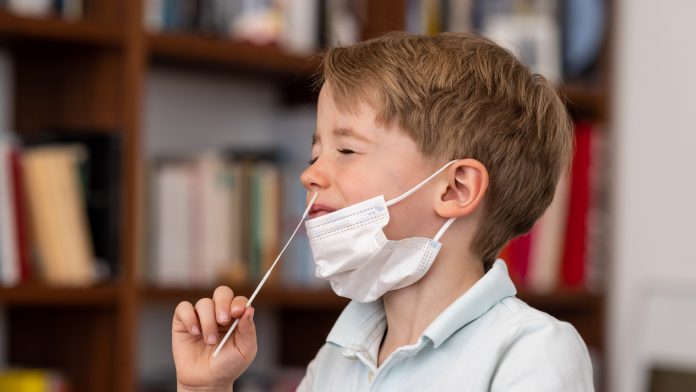
A new extensive study suggests that long COVID symptoms in children aged up to 14 years can persist for at least two months following a COVID-19 diagnosis.
Published in The Lancet Child & Adolescent Health, the largest study ever analysing long COVID symptoms in children has identified that those with a positive diagnosis can experience symptoms that last at least two months. The study utilised data from children in Denmark, matching positive COVID-19 cases with a control group who had no previous history of SARS-CoV-2 infection.
Professor Selina Kikkenborg Berg, from Copenhagen University Hospital, said: “The overall aim of our study was to determine the prevalence of long COVID in children and infants, alongside quality of life, and absence from school or daycare.
“Our results reveal that, although children with a positive COVID-19 diagnosis are more likely to experience long-lasting symptoms than children with no previous COVID-19 diagnosis, the pandemic has affected every aspect of all young people’s lives. Further research into the long-term consequences of the pandemic on all children will be important going forwards.”
How prevalent is long COVID in children?
Earlier investigations into long COVID in children and young people have predominantly focused on the effects on adolescents, with toddlers and infants being unrepresented. To overcome this research gap, the researchers sent questionnaires to the parents of children aged between 0-14 years who had tested positive for COVID-19 between January 2020 and July 2021.
The researchers received around 11,000 responses for children with a positive COVID-19 test, subsequently matching these results by age and sex to more than 33,000 children who had never tested positive for the disease.
The survey comprised questions about the 23 most common symptoms of long COVID in children, with the most common among children aged 0 to three years being mood swings, rashes, and stomach aches. The most common in four to 11 years old were mood swings, memory problems and trouble concentrating, and rashes, and among 12 to 14 years old, fatigue, mood swings, and trouble remembering or concentrating.
The findings suggest that all age groups of children diagnosed with COVID-19 are more likely to exhibit at least one symptom of the virus for two months or longer than the control group. For those aged between 0 to three years, 40% of those diagnosed with COVID-19 experienced symptoms for more than two months compared to 27% of controls. The prevalence in those between four to 11 years was 38% compared to 34% of controls, and for the 12 to 14 years, 46% of cases experienced long COVID symptoms compared to 41% of controls.
The effects of Long COVID
Non-specific symptoms of long COVID in children include headaches, mood swings, abdominal pain, and fatigue are usually experienced by healthy children but are also common conditions that can be unrelated to COVID-19. However, the investigation revealed that these long-lasting symptoms were more likely to be experienced by children with a positive diagnosis than those who had never been diagnosed with the disease, suggesting they are symptoms of long COVID.
This is reinforced due to a third of the participants with a positive diagnosis demonstrating symptoms that were not present before the infection. Moreover, as the duration of the symptoms increased, the number of children with those symptoms decreased.
Children diagnosed with the disease reported fewer psychological and social problems than the control group, and in older age groups, children generally felt less scared, had less trouble sleeping, and felt less worried about their condition. The researchers explained that this might be because of more pandemic awareness in older age groups, with the control group experiencing more fear of the disease and restricted everyday life due to trying to avoid the virus.
Professor Berg commented: “The opportunity to undertake such research is rapidly closing as the vast majority of children have now had a COVID-19 infection; for example, 58% of children in Denmark had lab-confirmed infection between December 2021 and February 2022. Knowledge of the long-term symptom burden in SARS-CoV-2 positive children is essential to guide clinical recognition, parental caregiving, and societal decisions about isolation, lockdown, non-pharmaceutical interventions, and vaccine strategies.
“Our findings align with previous studies of long COVID in adolescents showing that, although the chances of children experiencing long COVID is low, especially compared to control groups, it must be recognised and treated seriously. More research will be beneficial to treat and better understand these symptoms and the long-term consequences of the pandemic on children going forward.”
Study limitations
The team outlined some potential limitations of the study. For example, there was a long recall period between COVID-19 diagnosis and taking the survey and the research heavily relied on parent-reported data that can be less accurate for psychological symptoms.
This can result in selection bias due to the parents of children with severe symptoms being more likely to respond, leading to the results representing the most affected children. Furthermore, testing for COVID-19 was only available from August 2020, which means that some of the children in the control groups could have had undiagnosed asymptomatic infections.
Maren Rytter, from the University of Copenhagen, who was not involved in the study, concluded: “Although the study found that symptoms of any kind were slightly more frequent in children who had been infected with SARS-CoV-2, the overall impact on children of having had COVID-19 is probably small, and likely much less than the impact of the indirect effects of the pandemic. For most children with non-specific symptoms following COVID-19, the symptoms are more likely to be caused by something other than COVID-19, and if they are related to COVID-19, they are likely to pass with time.”








